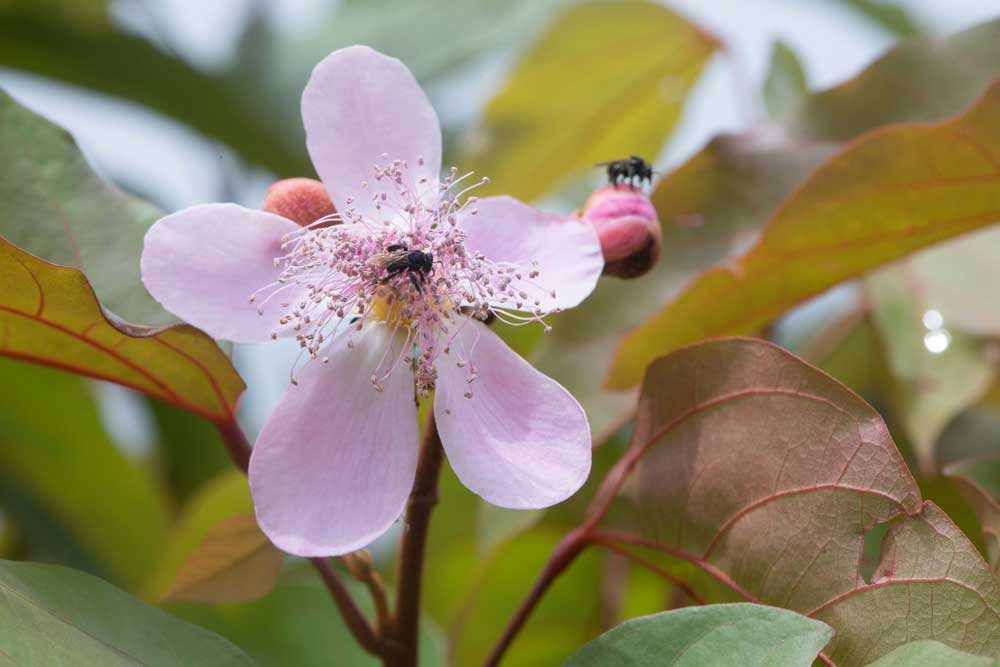
Are you saying I can eat that face paint?
Share
If you, like me, have lived in Costa Rica for long enough you might know of some of the local traditional recipes or dishes. And in that case, you might be familiar with Annatto also known as achiote. Here in Costa Rica, it is most commonly found in stores as a thick deep red paste. And if you have gotten the extra special fortune of seeing it on the tree before it’s been harvested and sent off for processing you would be wooed by its almond shaped, soft, long spiny, bright red, fruit capsule in which when opened you will find a hollow tidy whitish locket with rows of the same deep red seeds. The flowers on the midsized bush are delicate pink flowers that remind me of strawberry blooms with very little aroma. In every way Annatto stands out as a spectacle that never fails to brighten your day.
As one of the truly traditional staple spices in central America it can be found in moles in Mexico and to tone up the red or orange color of many dishes. Its subtle mildly peppery, earthy, and slightly sweet flavor and aroma but powerful color gives it an extra-ordinary versatility. It’s one of those species that no one would avoid because they don’t like it. It’s used in many rice dishes, meat rubs, and bases for marinades and stews.
And since you are here reading my blogs you can bet, I will include the ceremonial, medicinal and therapeutic traditions it has been included in too.
If you can imagine after a few years of growing Annatto and appreciating it for its color and always loving the way it was used in face and body paints in the Maleku community. The Maleku here in the northern zone of Costa Rica are an indigenous people who Rob, and I have had some fortune to spend some time with over the years. We have seen it used on their face body and to paint crafts there. So, for some reason it took until my sister, Jaki, had heart surgery for me to realize some of its medicinal gifts.
After Jaki’s surgery I was searching for some things to help her heal her tissues and came across a pill form of Annatto on the internet which led me to start digging around in my library of herbal books. I learned that Annatto has a perfectly measured composition of tocotrienols, which are what scientists call Vitamin E, for human tissue healing. Not to mention packed with antioxidants. So, it’s great for internal use, eating, to give our bodies the Vitamin E it can use to replace damaged tissues but also is great on the surface of the skin as it is also a powerful microbial to keep infections at bay. It’s also a great sunscreen but I am not sure you would want to use it for that as it does stain your skin for several hours a bright red color. I personally would recommend it more for lipstick or other highlights of makeup.
It has been used for centuries to treat indigestion, heartburn, and stomach discomfort as well as used to make teas or poultices believed to treat fever, infections, and soreness from inflammation. It, like foods like berries, leafy greens, turmeric, and fatty fish contain compounds that protect brain cells and reduce inflammation in neural tissues like brain fog, depression, anxiety, and cognitive decline (which is handy as I traverse perimenopause to menopause. all tools are welcome). With its abundant sources of vitamins A, C, E, and zinc it’s a great addition to an anti-inflammatory diet with a ton of fun color without the overpowering flavors and aromas some other spices offer with similar health benefits.
We only dry and package our annatto at Cicno Ramas so we don’t offer it in a paste as you often will see in a local market here. We take great care to ensure that folks get only just that 1 ingredient but with this you will have to take an extra step. Some of the options include soaking the seeds in water, vinegar or high-quality oil to soften them and then use both the seeds and the liquid in your next dish. Most grandmas in the northern zona set them in their liquid at night and use it the next day, which is nice and not so complex. In our house, as spice nuts, we either use a mortar and pestle or put some seeds in the spice grinder (also known as a pepper mill or coffee grinder, both works great) and use the powder in our meals.
I hope you choose to experiment with one or more of these techniques as each are fun and offer different results and are better for different applications. And let’s be honest if you were to read the ingredients of that paste you might realize you are eating a few things you would prefer not to.
Thank you for exploring healing spices with me. I am overjoyed you have made it to the end of this blog and look forward to sharing more with you.